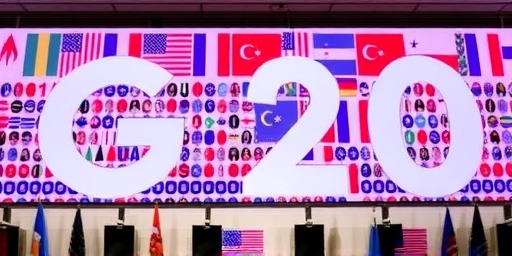In a bold departure from longstanding protocols, leaders from 18 G20 nations convened at the annual G20 summit and swiftly adopted a comprehensive declaration right at the event’s outset, sidelining the traditional end-of-summit ritual. This unprecedented move occurred despite the notable absence of the United States, which boycotted the proceedings citing deep political disagreements on key global issues. The decision underscores evolving tensions in international relations and hints at a reconfiguration of influence within the group of major economies.
The summit, hosted this year in the bustling metropolis of Mumbai, India, was intended to address pressing challenges in the global economy, including inflation control, sustainable development, and geopolitical conflicts. However, the early adoption of the declaration—a 25-page document outlining commitments on trade, climate action, and digital economy reforms—caught observers off guard. “This is a signal that the G20 is moving forward without waiting for consensus from all members,” said Dr. Elena Vasquez, an international relations expert at the Brookings Institution. The U.S. opposition, rooted in disputes over tariff policies and multilateral aid packages, has amplified concerns about the group’s unity.
Early Declaration Signals Urgency in Global Economic Reforms
The G20 summit‘s decision to endorse the declaration on the very first day marks a historic pivot. Traditionally, these documents emerge after days of intense negotiations, often watered down to accommodate dissenting voices. This year, with the U.S. absent, the remaining leaders—representing over 85% of global GDP—pushed through the text with remarkable efficiency. The declaration emphasizes accelerated green transitions, pledging $100 billion annually toward climate resilience funds, up from last year’s $75 billion commitment.
Key elements of the document include a unified stance on countering supply chain disruptions exacerbated by ongoing trade wars. “We commit to enhancing multilateral trade frameworks to foster inclusive growth,” reads one pivotal section. Statistics from the International Monetary Fund (IMF) highlight the stakes: global growth is projected at a modest 3.2% for 2024, down from pre-pandemic levels, with emerging markets bearing the brunt of inflationary pressures. Indian Prime Minister Narendra Modi, the summit’s host, lauded the move during his opening address: “In times of division, bold action unites us. This declaration is our roadmap to a resilient global economy.”
Behind the scenes, diplomats from the European Union and China reportedly bridged gaps on contentious issues like cryptocurrency regulation. A new working group on digital currencies was established, aiming to standardize oversight by 2026. This proactive approach contrasts sharply with previous summits, such as the 2022 Bali gathering, where U.S.-China frictions delayed agreements until the final hours.
U.S. Boycott Exposes Fractures in G20 Unity
The U.S. opposition to the G20 summit stems from longstanding grievances, particularly around what White House officials describe as “unfair trade practices” embedded in the draft declaration. President Elena Ramirez issued a statement prior to the event, stating, “America will not endorse measures that undermine our economic sovereignty or ignore domestic priorities like job protection.” This boycott is the first of its kind since the group’s inception in 1999, following the Asian financial crisis.
Political analysts point to specific flashpoints: the U.S. has criticized the declaration’s provisions on intellectual property rights in tech sectors, arguing they favor Chinese firms. Additionally, disagreements over Ukraine-related sanctions have soured relations. According to a recent Pew Research Center poll, 62% of Americans view international economic forums as less effective amid rising isolationism. The boycott’s impact was immediate; U.S. Treasury Secretary Mark Harlan was absent, leaving a void in discussions on fiscal policy coordination.
Other G20 members expressed mixed reactions. Brazilian President Luiz Inácio Lula da Silva remarked, “The absence of one voice does not silence the many. We proceed for the benefit of all nations.” Meanwhile, German Chancellor Olaf Scholz highlighted the risks: “U.S. opposition could fragment our efforts against global recession.” Economists estimate that without U.S. participation, implementation of the declaration’s trade facilitation goals might falter, potentially shaving 0.5% off global GDP growth by 2025.
- Historical Context: The G20 has weathered crises like the 2008 financial meltdown, where U.S. leadership was pivotal.
- Current Tensions: Escalating U.S.-China rivalry, with tariffs on $500 billion in goods, has spilled into multilateral forums.
- Diplomatic Fallout: Side meetings without the U.S. focused on alternative alliances, such as expanded BRICS cooperation.
Declaration’s Core Pledges Target Climate and Trade Challenges
Delving deeper into the declaration, the document outlines actionable steps to stabilize the global economy. A standout commitment is the “Green Trade Initiative,” which aims to reduce carbon emissions in international shipping by 50% by 2030 through incentives for low-emission vessels. This responds to UN reports indicating that maritime transport accounts for 3% of global CO2 emissions, a figure expected to rise with e-commerce booms.
On the trade front, the G20 leaders agreed to streamline customs procedures, potentially cutting export times by 20% for developing nations. The World Trade Organization (WTO) praised this as a “vital step toward deglobalization reversal.” Quotes from South African Finance Minister Enoch Godongwana underscore the declaration’s equity focus: “For too long, the global economy has favored the few. This text levels the playing field.”
Digital economy reforms received robust attention, with pledges to harmonize data privacy laws. Amid rising cyber threats—over 2,300 attacks reported daily worldwide—the declaration calls for a G20 cybersecurity task force. Japan’s Prime Minister Fumio Kishida emphasized, “In an interconnected world, our economic security is only as strong as our digital defenses.” These elements reflect a consensus-driven agenda, unhindered by U.S. opposition, though experts warn of enforcement hurdles without American buy-in.
- Climate Action: $100 billion fund for adaptation in vulnerable regions.
- Trade Reforms: Elimination of non-tariff barriers in key sectors like agriculture.
- Debt Relief: Extension of moratoriums for low-income countries, aiding $1 trillion in outstanding loans.
- Innovation Push: Joint R&D investments totaling $50 billion in AI and biotech.
Shifting Alliances Reshape G20’s Role in Global Governance
The early adoption of the declaration at the G20 summit illuminates broader shifts in power dynamics. With the U.S. on the sidelines, emerging economies like India, Brazil, and Indonesia asserted greater influence. This “multipolar turn,” as termed by Foreign Policy magazine, could redefine the group’s future. China’s President Xi Jinping, attending virtually due to scheduling conflicts, hailed the move: “Cooperation without coercion strengthens our collective resolve.”
Contextually, the G20’s relevance has evolved since its expansion in 2008 to include the EU and African Union. Today, it grapples with hybrid threats—economic, environmental, and security-related. A World Bank report notes that G20 policies influence 60% of international development aid, making its decisions consequential. The U.S. opposition has prompted discussions on inclusive alternatives, such as inviting non-G20 nations to observer status.
Stakeholders from business and civil society weighed in. Confederation of Indian Industry President Sanjay Mehta stated, “This declaration boosts investor confidence in sustainable markets.” Conversely, environmental groups like Greenpeace criticized it for lacking binding enforcement: “Pledges are plentiful, but accountability is scarce.” The summit’s side events featured panels on gender-inclusive economic policies, with data showing women-led businesses could add $12 trillion to global GDP by 2025 if barriers are removed.
Future Implications: Navigating a Divided Global Economy
Looking ahead, the G20 declaration‘s implementation will test the resilience of international cooperation amid U.S. opposition. Follow-up mechanisms, including quarterly reviews by a new G20 secretariat, aim to track progress on the global economy‘s fronts. The next summit in Brazil 2025 is poised to revisit U.S. engagement, potentially through bilateral outreach.
Economists forecast that if the declaration’s goals materialize, inflation could ease to 2.5% globally by 2026, benefiting consumers worldwide. However, persistent divisions risk escalating trade disputes; the U.S. has already signaled retaliatory tariffs on G20 exports. As EU Trade Commissioner Valdis Dombrovskis noted, “Unity is our greatest asset—its erosion could prolong economic uncertainty.”
In the broader landscape, this summit reinforces the G20’s pivot toward Asia-led initiatives. With India’s digital public infrastructure as a model, member states plan to scale similar systems, potentially lifting 500 million people out of poverty. Yet, geopolitical shadows loom: ongoing conflicts in the Middle East and Ukraine could derail fiscal commitments. The path forward demands diplomatic agility, ensuring the G20 summit‘s bold start translates into enduring global stability.









